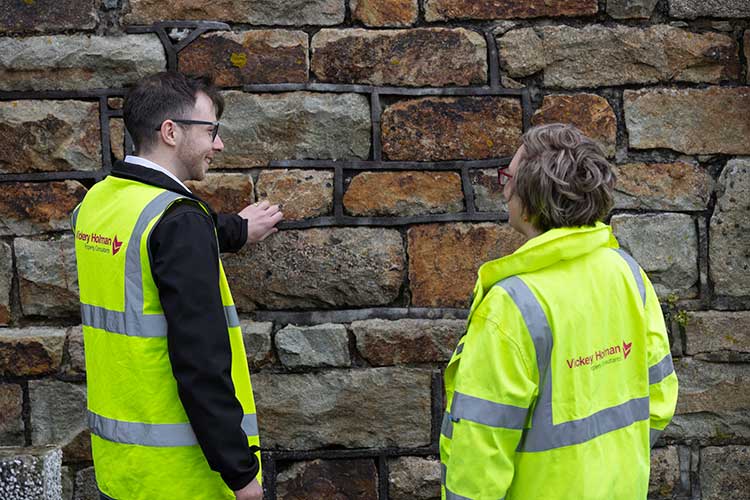Boundary & Building Disputes
Disputes about boundaries or buildings can occur and when they do, the team at Vickery Holman can help you reach an agreement or settlement.
Home / Services / Litigation / Boundary & Building Disputes
Boundary Disputes

A boundary dispute is a dispute that arises between owners or occupiers of neighbouring properties. Sometimes a boundary dispute will arise when one party constructs a fence, wall or building in a position which highlights that the two neighbours have different views on the location of the boundary. In other cases, a dispute may arise when a property is sold or portioned off and the boundaries are not sufficiently clear, potentially leading to trespass by the new owner or disagreement with neighbours over who owns what.
Finally, a common cause of boundary disputes starts with someone scaling up their Land Registry Title plan to show that their boundary on the ground is not the same as the Title boundary. There are several pitfalls with this approach:
- The Land Registry Title plans do not (except in the rare case of a ‘determined boundary’) establish the legal boundaries of the properties with any precision.
- The plans used by the Land Registry are based on Ordnance Survey maps and are considered to show site features at the time of registration and ‘general boundaries’ only. In these cases, the exact line of the boundary is left undetermined, regardless of what appears to be shown on the Title plan.
- The thickness of the line on the plan itself can be as wide as 1m on the ground, allowing for the thickness of the line plus the relative accuracy and margin of error on OS maps that are generally at a 1:1250 scale.
- All of this shows that reliance on Land Registry Title plans alone will, generally, be insufficient.
The danger with a boundary dispute is that unless the area of land has substantial value, the costs incurred can quickly become disproportionate to the value of the land in dispute, especially if the matter escalates to instructing solicitors.
To resolve a boundary dispute, first the parties should clarify their understanding of the boundary. You should review Title plans, deeds and conveyance documents for both properties. Documents can vary in quality, sometimes containing detailed plans and descriptions but, often, this is not the case.
If you cannot agree with your neighbour on the boundary line, you can instruct a surveyor to provide their expert opinion on the matter. This will often include the production of a detailed plan of the boundary, which will help to clarify the surveyor’s opinion.
The surveyor can be instructed jointly by both parties to determine the location of the boundary line. The parties can agree to be bound by the surveyor’s determination. Alternatively, the surveyor can be appointed by one party, who could use the report as part of a court claim. In this case, the parties are not bound by the surveyor’s decision and it would be for solicitors to resolve the dispute. Less costly alternative dispute resolution methods, such as mediation, arbitration and adjudication, should be considered before going to court.
How to avoid a boundary dispute?
- Aim to know your boundaries and, if they are unclear, try to agree them with your neighbour before a dispute is raised.
- When purchasing property, have a survey done to pick up any unusual boundary features or possible existing trespass from or over neighbouring property. Your conveyancing solicitor should carefully review what is and isn’t included in the Title deeds. Talk with neighbours about whether there are any ongoing disputes; you should ask the vendor about any ongoing or historic disputes.
- When building on or near your boundary, speak with your neighbour to check that they agree with your understanding of the boundary location. Remember that the Party Wall Etc. Act 1996 deals with building on the line of boundary and is a legally binding method of dispute avoidance that protects both you and your neighbour.
Building Disputes

A building dispute often occurs following works to a property, or a change of occupant, owner or building condition, which allows defects to be found. A lot of common issues arise in relation to building matters, often based upon a failure in communication between the parties or a mismanagement of expectations.
The first thing to do is communicate with all parties involved. If building work is being done to a property and a defect is found (e.g. poor workmanship, missing work, inappropriate materials etc.), you can raise it with the builder to give them a chance to resolve the matter. Similarly, a tenant who has a problem with their property (e.g. damp, broken/damaged building parts) can raise it with the landlord.
However, if agreement cannot be reached, you can choose to appoint a building surveyor to inspect and provide their expert opinion on the matter. Their report can then be used as a negotiating tool in discussion with the parties or to support a legal claim. Alternatively, the parties can instruct a surveyor jointly to provide a determination and can agree to be bound by that determination. This allows the surveyor to set out exactly what remedial works may be required and knowing that it will be carried out.
The surveyor will inspect the property, review any relevant documents such as contracts, specifications, drawings etc. and provide their opinion on the defect, including recommended remedial work. Costs for the remedial work can be included if required.
How to avoid a building dispute?
Records, records, records!
- When you have building work done, ensure you have the correct paperwork in place; contracts, drawings, specifications of work etc. are all vital to clarifying the cost, scope and timing of works. The larger the project, the more important these documents are.
- Supervision of the works is also important; for larger projects you may want to consider instructing a building surveyor to monitor progress, cost and quality of work on your behalf.
- When leasing a property, you can instruct a building surveyor to undertake a schedule of condition, which will record the condition of the property at the beginning of the lease. This can be used to support requests to a landlord for repair work.
- Keep records of work undertaken, including photos of work in progress, and contact details of contractors involved.
- Where possible, aim to use contractors who will provide insurance-backed warranties for their work, which can cover defects found once the work is complete.
Communication is key:
- Keep regular contact with builders, landlords, tenants, etc. to prevent any problems from escalating into a dispute.
- If a problem is found, try to stay calm and neutral to avoid the dispute becoming personal.
Key Contacts
Boundary & Building DisputeFAQs
What are common causes of boundary disputes?
Boundary disputes often arise due to discrepancies in property boundaries, encroachments, unclear or outdated boundary documentation, or disagreements over rights of way and access.
How can I determine my property's boundaries?
Chartered surveyors can conduct boundary surveys using advanced surveying techniques and historical research to advise on the likely location of property boundaries and help resolve disputes. If instructed by both parties on a boundary, the surveyor can accurately determine the boundary and produce an accurate plan for submission to the Land Registry; this is then included in the Titles of both properties.
What should I do if I'm involved in a boundary dispute?
Seek advice from a chartered surveyor specialising in boundary disputes. They can assess the situation, provide expert guidance, and facilitate negotiations with neighbouring property owners.
What types of building disputes commonly occur?
Building disputes may arise due to defects in construction, delays in the project timeline, disagreements over payment terms, breaches of contract, or design errors.
How can chartered surveyors assist in resolving building disputes?
Chartered surveyors can provide expert advice, conduct inspections to identify defects or compliance issues, prepare expert reports, and act as mediators or expert witnesses to help resolve building disputes.
What is the process for resolving building disputes through the Party Wall Act?
The Party Wall Act requires building owners to serve notice to adjoining property owners before carrying out certain types of construction work. Specialist party wall surveyors can assist with serving notices, negotiating agreements, and preparing Party Wall Awards.
How can I ensure compliance with building regulations and planning permissions?
Chartered surveyors can provide guidance on navigating building regulations and planning permissions, ensuring that construction projects comply with legal requirements and obtain necessary approvals.
What role do chartered surveyors play in property transactions?
Chartered surveyors can provide valuations, building surveys, and due diligence services to support property transactions. They assess property condition, identify potential issues, and provide expert advice to buyers, sellers, and lenders.
How can I find a reputable chartered surveyor?
Look for surveyors who are members of professional organisations such as the Royal Institution of Chartered Surveyors (RICS) and have experience in the specific type of dispute or property transaction you’re involved in.
What are the benefits of hiring a chartered surveyor for boundary and building disputes?
Chartered surveyors bring expertise in property law, construction, and dispute resolution, helping to navigate complex legal and technical issues, negotiate favourable outcomes, and ensure that disputes are resolved efficiently and effectively.
Remember, every boundary and building dispute is unique, and it’s essential to seek tailored advice from a qualified chartered surveyor to address your specific situation effectively.






